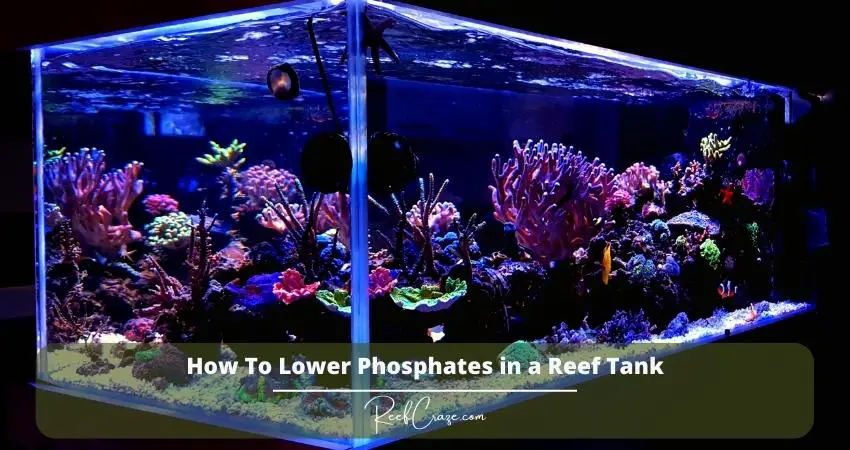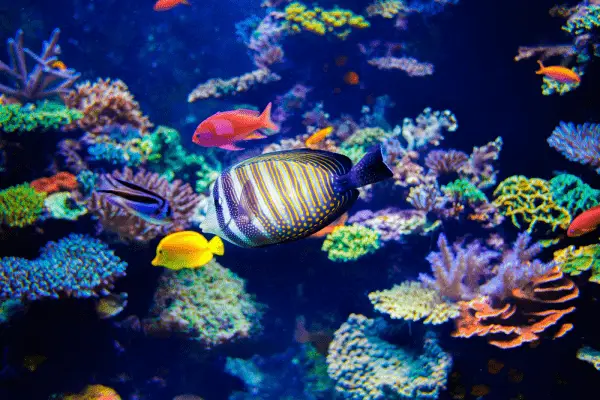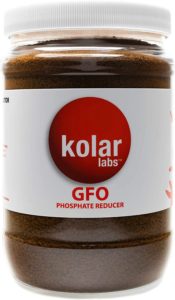An increased level of phosphate is a nuisance many aquarists fight against in their reef tanks. Due to the higher level of phosphates, several kinds of hair algae grow up in a tank and make the tank ugly. Moreover, it creates some other annoying problems.
You can lower the level of phosphates by changing water, using macroalgae, algae scrubbers, chemical products, maintaining food routine, filtering mechanically, adjusting proper lighting system, adding lime water, cultivating algae eaters, etc.
In this article, I am going to tell you about phosphate and the role it plays in reef tanks. I will also explain the source of phosphate in short. And finally, I will share some tips on how you can lower phosphate in your reef tank. So, don’t skip any part of this post if you are a serious reef aquarist.

What is Phosphate and What It Does to Your Tank?
Phosphate is a kind of nutrient that consists of chemicals containing oxygen and phosphorus ions (PO4). Practically speaking, phosphate exists in all living things in the ecosystem, especially in the marine. That’s why it is present in all tanks or aquariums whether it is a reef tank or not.
Now, you might ask whether phosphate is harmful to your reef tank or not. As generally, phosphate remains present in the reef tank, an average or standard level of phosphates is not that harmful actually.
On the other hand, an excessive level of phosphates helps to grow up the hair algae and green hair algae specifically. The tissue of corals might get affected by the excessive growth of brown algae as well. It masks the natural color of the corals and makes them look brown.

Moreover, phosphate is responsible for restricting the calcium carbonate uptake. As a result, the growth of the coral skeleton gets hampered.
For all of these reasons, you have to be careful so that your reef tank does not get affected by the negative impacts of excessive phosphates.
Having a healthy and tolerable level of phosphate is essential for maintaining the growth of the fishes and other creatures in the tank.
So, what is the reasonable amount of phosphate you should be targeting to maintain in your reef tank? Though it might vary for a variety of reasons, an amount of 0.05 ppm-mg/l to 0.1 ppm-mg/l is good to go.
What causes high phosphates in saltwater aquarium
As I said earlier that phosphate exists in all living things, reef tanks are no exception. Apart from the natural existence, phosphate might come in your reef tank from a variety of external sources. Let’s explore some of the common sources of phosphate in the reef tank:
Water
Generally, water is the main root of having phosphate in your reef tank as it exists in the water. Seawater carries an excessive level of phosphates. In a confined reef tank, phosphate increases day by day.
Fish Waste
Fish wastes can also gather phosphates in your reef tank. Any dead or decaying objects also emit phosphates into the tank.
When any waste and detritus start to break down, phosphates come out of them and get mixed in the water.
The amount of phosphate in the water depends largely on the number of fishes. More fishes will leave more wastes in the water and that will produce more phosphate in the tank. That’s why controlling phosphate is more expensive and time-consuming in a bigger aquarium.
Fish Food and Fish Food Residual
Fish food contains a higher portion of phosphate. Overfeeding your fishes can skyrocket the phosphate level in the tank water. Besides, if you supply too much food for the fishes to consume, the food residual can bring about more phosphate in the water.
The leftover foods continue to create phosphate unless and until you draw away the excess food from the tank.
Poor Quality Water
The use of the unfiltered water in the reef tank is another way to invite the phosphates in the water. Unfiltered water contains a high level of Total Dissolved Solids (TDS) which is responsible for high phosphate.
To get rid of poor quality water, you should replace the tap water with RO/DI water filter system. This system will make sure that the water you are adding in the tank comes with zero TDS.
Other Sources
As hair algae grow up with the help of phosphates, it comes from the dead hair algae of your reef tank. So, do not leave the dead hair algae, rather clean it.
Lighting also matters in the case of increasing phosphates.
Furthermore, the live rocks in your reef tank also cause phosphates to rise.
How To Lower Phosphates In Reef Tank?

From the previous sections, you have got to know about phosphate, its sources, and its impact in the reef tank. Let me now tell you some of the ways to lower the phosphates.
There are some proven methods to apply when it comes to lowering the level of phosphates from the reef tank.
I’m going to explain some of the methods one by one below. Follow these to achieve your goal of controlling the excessive phosphates from the reef tank.
Changing the Water
It is a very recognized fact that water functions as the main factor in increasing the amount of phosphates in a reef tank. So, initially, changing water is the principal step you have to take.
You should change the water of your reef tank according to what kind of water you have in your tank.
Tap water is favorable for phosphates to rise. And seawater is also cordial to assist the growth of phosphates. That’s why Reverse Osmosis (RO) and Deionized (DI) water are very effective.
So, choose the proper type of water for your reef tank. Regular water change is way more difficult to do and it is not always possible. It will take extra time and also make you sweat.
That’s why try to change the water with a planned schedule. In this case, you should change about 10% to 20% of the water of the tank in a week. You can expect to reduce the phosphate levels by doing it properly as per the schedule.
Having Macro-algae and Algae Scrubber
If you want the reduction of phosphates, cultivate macroalgae or have a turf algae scrubber in your refugium.
Growing Macroalgae or having a turf algae scrubber also helps to limit the level of phosphates.
There are some species of macro-algae such as Caulerpa racemosa and Chaetomorpha, which are very helpful. These Macro-algae grow quite rapidly and consume phosphates. In this way, they deal with phosphate and bring it considerably under their control.
Algae turf scrubber also works in the same way. Over time, phosphate is quickly accumulated in the scrubber. When there are enough phosphates in the device, just clean it physically.
Keeping Protein Skimmer
You can discard the organic waste of your reef tank by using a protein skimmer. It is very common for an aquarist to have a protein skimmer. It works in a noticeable way certainly. The organic waste, released by your fishes, creates phosphates.
So, a protein skimmer is verily applicable in this case. It dissolves this organic waste into a cup. When the cup is filled, remove and clean it. Thus, a protein skimmer helps to control the phosphate level.
Using Binding Media
Using binding media is probably one of the most useful methods of lowering the phosphate level. Some absorbing products consume a higher level of phosphate and limit it incredibly. These media work as good options serving the purpose of lowering phosphate.
The most familiar absorbing media is the Granular Ferric Oxide which is known as GFO. It is a great phosphates collector and absorber indeed.
The system is very simple. Just keep a GFO media somewhere on your reef tank. By using media, it will bind the phosphates in its body. Finally, you have to export the media outside and remove the phosphates. Replace it again to catch more phosphates.
Remember that GFO works slowly. You can take almost 1-3 months to change the GFO. It is familiar in different names such as Phosphate Killer, Rowaphos, and Phosban.
Another common binding medium is Aluminum oxide. Like GFO, it also binds the phosphates and absorbs it. But, it works quicker than GFO. You have to change it only once a week. The common Aluminum oxides are Seachem’s Phosguard and Kent’s Phosphate Sponge.
Besides these, Lanthanum Chloride and Phos FX are also the effective binding media that remove phosphates. Note that, Phos FX is newly introduced.
And there are also some other liquid removers like Ultralife Reef, Blue Life Phosphate Rx, and Brightwell Phosphate-E. To get a better benefit from these, you can keep one where your protein skimmer is placed.
Additional Read: PhosGuard Vs. GFO
Adding Kalkwasser/Limewater
In one of their studies, SeaScope Magazine has found that adding Kalkwasser or lime water is associated with the drop of phosphate level in the water. Learn more about Kalkwasser dosing from here.
Filtering Mechanically
Filtering is a common and popular way to get rid of the higher amount of phosphates. If you have more fish, it is very normal to have more phosphates. Fishes release their wastage and the broken foods also emit phosphate.
The wastage and uneaten food cause an increase in phosphate levels. For this reason, you should filter this wastage following a routine so that phosphate can not go up. Besides, living rocks also should be cleaned after some days.
Using Bacteria
You can contribute some carbon which causes you to exceed bacteria. Carbon like sugar, vinegar, nopox, bio pellets, ethanol can be used for this purpose.
Note that Nopox is much more useful than others. Using this carbon helps to grow the bacteria. And the bacteria will absorb the nitrogen and phosphates.
Maintaining Food Routine
Food is essential for your reef inhabitants. To grow up healthily, you must provide the proper foods. In this case, you have to be more careful. Since sufficient food should be given with a regular planned routine. Overfeeding and underfeeding, both are harmful to them.
Due to overfeeding, much detritus causes the phosphates to increase. On the other hand, underfeeding is also detrimental to the inhabitants. So, maintain a proper food routine to get the expected result.
Keeping Algae Eaters
As you know that algae grow up with the help of phosphates, the presence of algae means the presence of phosphates. Therefore, follow the methods of removing algae from your reef tank. By it, you can remove phosphates also.
To achieve the aim, you can keep some algae eaters in your reef tank so that they can consume algae and release your tank from phosphates.
Some common algae eaters for reef tanks are Tangs, Snails, Lawnmower blennies, Hermit crabs, and Ghost shrimps. Every reef tank should have some algae in it. They are useful.
Using Vodka Method
If you are looking for an inexpensive and simple method to lower phosphate, I would ask you to try the Vodka method.
In this method, you have to add a small amount of Vodka or ethanol in the tank water after a certain interval. It works great to isolate phosphates and nitrates especially when you use it in combination with an effective protein skimmer.
Adding Minimalist Lighting System
The lighting system is also responsible for increasing phosphate levels. Over lighting helps to raise nutrients like phosphates and nitrates. So, do not add more lighting than necessary in your reef tank.
Rather, you should set a proper lighting system according to the size of your tank and the plants.
Things to Remember When Lowering Phosphate
Some phosphate lowering products work to lower the phosphate level drastically. You should keep your saltwater reef tank away from these types of products as far as possible. It is because the sudden drop in the phosphate level can create shock in the tank creatures. You should not aim to change the phosphate level in the tank overnight.
Before taking steps to lower phosphate, you should check the water to know the exact phosphate level in the water. You can use the Hanna Phosphate checker for this purpose.
When you know the phosphate level in the tank, you should decide how much phosphate you want to minimize from the water in the upcoming week. As per your decision, go with the right dose. Repeat this process until you have achieved your goal.
After reaching the desired level of phosphate in the reef tank, you should start using GFO to keep the level steady.
You should remove at best 1 ppm of phosphate per day from the system. Do not target to remove more than 1 ppm of phosphate. It is a must rule to follow especially if the tank had been with higher phosphate levels for a few weeks.
Take time and let the phosphate level drop gradually by the passage of time. Let the bio-systems cope with the change.
If you choose to use absorbing compounds or materials, make sure that you change or rejuvenate them after a certain period. Once they absorb up to their capacity, they get exhausted and become unable to work further.
So, if you want to keep any absorbing materials working, take them away from the system once they have filtered up to their limit. Otherwise, you will end up keeping the phosphate in the system.
Final Thoughts
Phosphate is a common issue for the aquarists. And, for this reason, all reef keepers must have a clear understanding of it. After reading the article, hopefully, you are now well acquainted with these standpoints.
So, whenever you notice the excess of phosphates in your reef tank, just apply the methods mentioned above to lower it.
Remember, all the above-mentioned ways are not applicable for every reef tank. You just have to find out which are effective for you according to the presence of phosphates in your tank. And then work on implementing certain methods.


My corals are not growing; they are suffering from the negative effects of phosphate in the tank. How do I get them out of my tank?